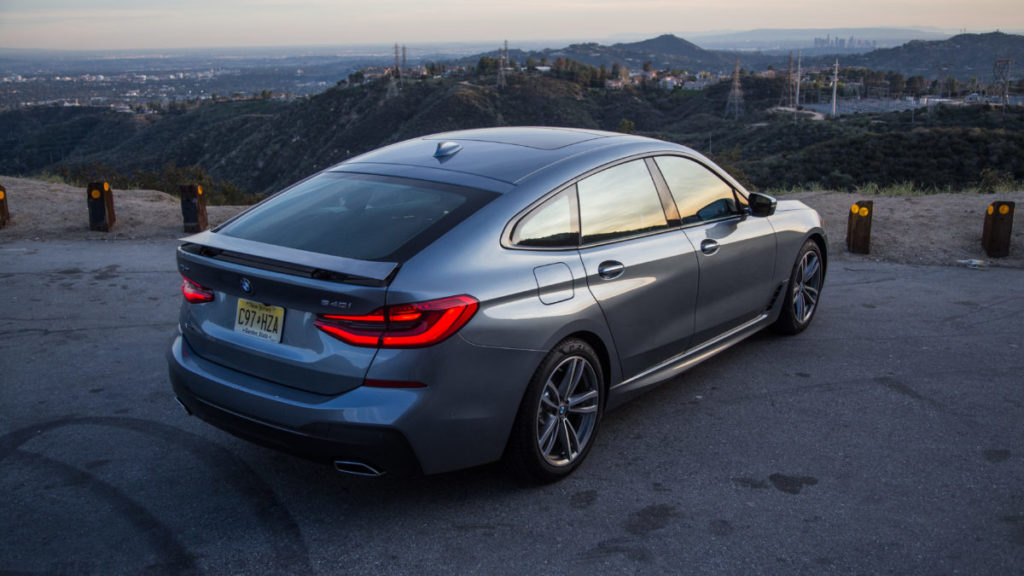Remember the futuristic self-driving car from the Will Smith movie iRobot? The one with the fold-out wheel (for operation “by hand”) that was attacked by robots in the second act?
Last week I found myself getting a taste of that science-fiction reality in a BMW 640i GT—and despite the fears of many enthusiasts (including my own), I can say that the future is going to be a little more fun and driver-friendly than we had anticipated.
BMW’s newest crack at the “tall hatchback” body style has been receiving attention for less-than-ideal reasons; its predecessor, the 5 Series GT, was regarded as having a rather ungainly appearance, and although it was available with the 440-horsepower twin-turbo V8 in the 550i GT, the driving dynamics were somewhere in between a crossover and a luxury sedan.
The new model, however, is quite a bit sleeker and more finely tuned, and while the V8 option is gone, the G30 5 Series-based grand-tourer is an adept and enticing athlete with the spectacular B58 turbocharged inline-six and a lighter, stronger chassis. And of course, for my video production work, the 640i GT’s gaping rear maw was a godsend for the seven bags and cases I need to transport during all my travels.
You can already imagine my relief facing down the six-hour drive from Thermal, California, to Las Vegas, Nevada, in this truly grand touring vessel—but the 640i GT had another trick up its sleeve: Since it’s based on the new 5 Series, it comes with a full host of semi-autonomous capabilities.
On the desert drive to Vegas, the system was put through ample testing. As in the 5 Series, Active Cruise Control and Lane Control Assistant can function independently or together, and a variety of safety measures are in place to deter over-reliance. You have to touch the wheel every few seconds, and the system will alert the driver should lane markings disappear.
The Autobahn-tested system worked well through the desert, although I was only able to convince the car to change lanes once by itself, and the system struggled slightly on tightening highway curves. And of course I had plenty of fun playing Will Smith by kicking the car out of automatic, Comfort Plus, and semi-autonomous mode into manual, sport, and conventional driving mode; such changeover is the epitome of what BMW’s selectable driving modes have achieved.
Yet it was only after four days of shuttling me in comfort that I made the trek back to Los Angeles and discovered the real magic of the system—and the reason BMW calls the ACC and LCA combination “Traffic Jam Assist.”
See, at under 20 miles per hour, the system does not require your hands to touch the wheel every fifteen seconds or so, and it has no struggle with following the curves of the road, however sharp. For one beautiful hour in evening commute traffic on the 405, I was carried blissfully along by the car, unbothered by the choice of which lane to select, or the persistent blinkers of those trying to squeeze in front of the GT.
From being cut off to cruising into openings, to following the meandering skyways of the 405, Los Angeles became a haven of comfortable seats, smooth leather, and Harmon-Kardon sound. The car took all the madness of LA evening traffic in stride, and left me free to explore the seats, storage cubbies, gigantic sunroof, and every corner of iDrive 6.0—plus fiddle constantly with the active rear spoiler and height-adjustable suspension.
By the time I had to give the car back to the Los Angeles press fleet, I was relaxed and refreshed. And combined with an earlier blast up a couple of Los Angeles canyons, the two opposite sides of the 640i GT had me palpably sad to return it.
To anyone doubting the semi-autonomous revolution, rest assured that—for BMW, at least—the Ultimate Driving Machine is still alive when you want it. And on stressful drives, you can remember what I told the valet: “Don’t worry. It practically drives itself.” —David Rose
